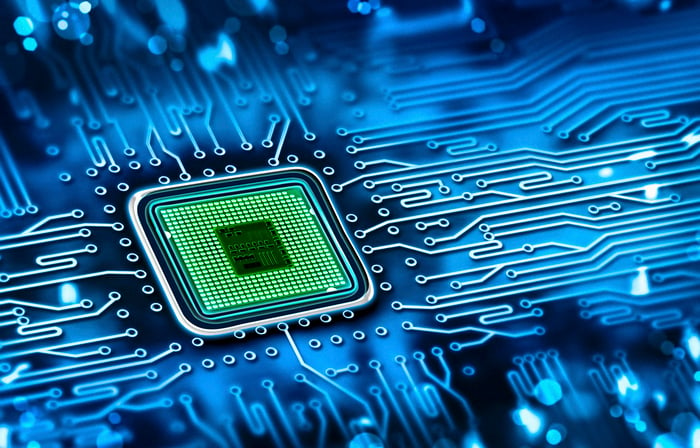Intel (INTC -3.67%) is in the midst of a massive turnaround plan -- one that includes catching up to rivals in CPU technology, inventing new AI-related platforms via its Gaudi accelerators, and building out a massive foundry for third-party chip manufacturing.
That turnaround will take money, and Intel's cash flow is highly dependent on the core PC CPU business, where it has traditionally dominated.
Yet coming off the worst PC rout in modern memory after the boom of the pandemic, Intel faces yet another challenge. In fact, it actually faces three big challenges, all coming at once for its cash-cow PC business -- and that could put its whole turnaround plan in jeopardy.
Qualcomm, Nvidia and AMD are coming
This week, Reuters reported that both Nvidia (NVDA -3.00%) and Advanced Micro Devices (AMD -4.76%) were "quietly" developing a PC processor based on the Arm Holdings (ARM -3.24%) architecture, which would run on the Microsoft (MSFT -1.32%) Windows operating system. According to sources cited by Reuters, these new chips from Nvidia and AMD will be available for PCs in 2025.
Of note, Microsoft had already recruited Qualcomm (QCOM -1.32%) to make Arm-based chips for Windows back in 2016, with an exclusivity deal that expires in 2024. On that note, Qualcomm just unveiled its new Arm chip for PCs on Tuesday, promising eye-opening performance.
Microsoft has seen Apple (AAPL -2.41%) take PC market share over the last few years, ever since Apple ditched Intel x86 chips for its own Arm-based M2 chips. In general, x86 chips, which are dominated by the traditional Intel and AMD duopoly, offer more performance, but they're generally less power-efficient than Arm-based chips. That's why Arm has found such a home in mobile devices. However, with the success of the M-series chips in Macs, Microsoft has taken notice, and is now looking to diversify.
Qualcomm just released its new Arm PC chip Tuesday
Nvidia and AMD are known as very innovative chipmakers, so one should expect some serious innovation and disruption in the PC world, especially as device-makers look to infuse PCs and desktops with artificial intelligence capabilities.
But already, Qualcomm looks to give everyone a run for their money, based on the specs for its new Snapdragon X Elite processor for Windows laptops, which it unveiled on Tuesday. These new chips should be available in Windows laptops sometime in 2024.
The new system-on-chip processor contains Qualcomm's Oryon central processing unit, an Adreno graphics processor, a Hexagon neural (AI) processor, RAM memory, and other circuitry that makes PCs run.
Based on Qualcomm's tests, the company claims the new Snapdragon chip outperforms the Intel i9 for gaming, as well as Apple's M2. The new chip is also apparently useful for artificial intelligence operations, capable of processing large language models with up to 13 billion parameters.

Image source: Getty Images.
Implications for Intel
Since Arm chips have been around for a long time, why haven't PCs adopted them more? Well, the x86 architecture is very well-ingrained, and software developers tend to develop PC software for x86 chips. Prior attempts at Arm-based tablets have typically been beset with glitches due to this. In fact, even Nvidia attempted an Arm-based processor for Microsoft tablets in 2012, but it was unsuccessful due to these software compatibility issues. So, that compatibility issue has traditionally offered a moat to Intel and the x86 architecture.
However, Apple was able to make the M-series work thanks to its in-house developed application compatibility software layer called Rosetta 2. Rosetta 2 was developed by Apple in 2020 in order to allow Intel-based software to run on Apple's Arm-based M2 chip, and it is what has made its M2-based Macs so successful.
Can Microsoft provide such a software translator? Microsoft certainly has the capability and financial resources. However, as Apple is able to optimize for the M2, Microsoft will have to make sure Intel software can run on the new Qualcomm chips, as well as those forthcoming from AMD and Nvidia, if they come. That's a more complicated task. Still Qualcomm CEO Cristiano Amon says, "We knew that as we moved from the x86 to an Arm-compatible instruction set, there would be a journey to get all of the applications and the performance ... I think the Elite X is us getting to the end of this journey."
If these new Arm chips are successful, even moderately, it would be devastating for Intel. The company is looking to regain its technology lead, build out foundries, and catch up to rivals in other ways. But its financial resources depend on cash flow from the wide-moat PC chip business. After the PC downturn over the past few years, now Intel must contend with the potential breaching of its moat in x86 PC chips. That could strain its financial capability even further.
Intel CEO Pat Gelsinger's turnaround just got that much harder.





